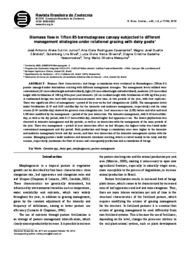Biomass flow in Tifton-85 bermudagrass canopy subjected to different management strategies under rotational grazing with dairy goats.
Biomass flow in Tifton-85 bermudagrass canopy subjected to different management strategies under rotational grazing with dairy goats.
Author(s): CAVALCANTE, A. C. R.
Summary: Biomass flow characteristics and forage accumulation were evaluated in Bermudagrass (Tifton 85) pasture managed under intermittent stocking with different management strategies. The management levels utilized were conventional (10 cm residual height and unfertilized), light (20 cm residual height and unfertilized), moderate (20 cm residual height with fertilization of 300 kg N/ha.year) and intensive (10 cm residual height with fertilization of 600 kg N/ha.year). A randomized design was used with repeated measurements over time, in two periods of the year, with four replicates. There was significant effect of management × period of the year on the leaf elongation rate (LER). The management levels under fertilization (0.59 and 0.60 cm/tiller.day for the intensive and moderate management, respectively) and the rainy season (0.49 cm/tiller.day) showed the greatest stem elongation rate. Leaf senescence rate (LSR) before and after and total LSR were modified by the management × period of the year interaction. The intensive management, with 0.38 leaves/tiller.day, as well as the dry period, with 0.27 leaves/tiller.day, showed higher leaf appearance rate. The lowest phyllochron was observed in intensive management and dry periods, as well as an interaction with the management of the same periods of the year. There was management × period of year interaction effect on leaf lifespan; the highest value was found under conventional management and dry period. Both production and forage accumulation rates were higher in the intensive and moderate management levels and dry season, and there was interaction of the intensive management system with the seasons. Managing pastures under moderate and intensive rotational stocking, which occurred mainly in the rainy and dry seasons, respectively, maximizes the flow of tissues and consequently production and accumulation of forage.
Publication year: 2013
Types of publication: Journal article
Unit: Embrapa Goats & Sheep
Keywords: Acúmulo de forragem, Adubação nitrogenada, Cabra leiteira, Capim massai, Capim-tifton 85, Caprino, Cynodon spp, Fertilizante nitrogenado, Fluxo de biomassa, Goats, Grassland Management, Grazing, Morfogênese, Morphogenesis, Panicum infestum, Pastejo rotativo, Rotational grazing, biomass, nitrogen fertilizers
Observation
Some of Embrapa's publications are published as ePub files. To read them, use or download one of the following free software options to your computer or mobile device. Android: Google Play Books; IOS: iBooks; Windows and Linux: Calibre.
Access other publications
Access the Agricultural Research Database (BDPA) to consult Embrapa's full library collection and records.
Visit Embrapa Bookstore to purchase books and other publications sold by Embrapa.

